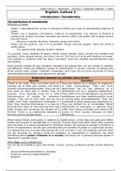Engels: Cultuur 2 – UAntwerpen – 2020-2021 – Toegepaste Taalkunde – F. Albers
English: Culture 2
Introduction: Outsidership
The significance of outsidership
Relations of power
- Power = idea behind the course Literature (fiction) as a way of representing relations of
power
- ‘Power’ has a negative connotation: relations of exploitation, e.g. slavery Radical &
unequivocal relation of power, whereby one person suffers the power that another person
has over them
o Physical, material, financial, mentally: enslave the other
- Power can be positive: use it to accomplish things, educate people, make the world a
better place…
o E.g. parent-child, teacher-student relation
In a society, many relations of power isolate certain people. Every society has insiders and
outsiders; some people belong, and others do not. This has a lot to do with relations of power.
The outsider is someone who has been “excluded” from the club/the mainstream/the ones
who belong.
Every society creates its own outsiders. Outsiders are people who, for one reason or another,
are different. There are different causes of outsidership. A society consists of people who
share certain ideas, values, traditions, languages, and if you do not share any/some of these
interests/features/qualities, you become an outsider.
Distinction between an outsider and a hermit
Hermits Outsiders
Tend to be male. They turn their back on They are defined by a relation of negativity
society out of their own volition; not really to their surroundings. They are thus
kicked out/ostracised/excluded. They just do determined not by the absence of a
not want to deal with a certain type of relationship but by a negative relationship.
society. They basically long for a total They suffer from not belonging to society/the
disconnection of society for whatever mainstream and bear experiences/the scars
reason. They live on their own, but do not of having been excluded/denied. They are
suffer from their isolation/not belonging. In connected to other people but negatively so.
fact, they become themselves in a way by They are defined by an incomplete, failed
turning their back on and severing their ties relationship of belonging. In general, they
with society and assuming the identity of a suffer from being excluded and denied full
hermit. There is no relationship between a access to their society because of their
hermit and the outside world. differences.
What makes literary texts great, in addition to style/humour, is that they articulate and reflect
modes and causes of outsidership in a society. A great novel very often deals with a person
who has been or is being outsidered for whatever reason. By looking at outsider’s literature in
terms of outsidership, we will gain understanding of relations of power in a particular society.
It is always the ones in power who decide who is in and who is out, who belongs and who does
not. By focusing on (various kinds of) outsiders as represented in literature, we learn
something about power relations in a society and about life in general because power is
important in people’s lives.
What may cause outsidership?
You can be an outsider in your own family, culture, country, profession and/or society because
of…
- Sexual preference/orientation, sexuality
- Economy, poverty (stigmatisation)
- Religion
1
, Engels: Cultuur 2 – UAntwerpen – 2020-2021 – Toegepaste Taalkunde – F. Albers
- Intellectual outsider: a different way of thinking than the mainstream; out-of-the-box ideas
that do not belong to the mainstream, respectable, defendable, etc.; punished for thinking
differently
- Race
- Physically different person; a bodily outsider
- Language (“Where are you really from?”)
- Having committed some kind of crime (and not owing up to it)
Nathaniel Hawthorne (1804–1864): The Scarlet Letter (1850)
‘But the past was not dead.’
(“The Custom House”, Introductory to “The Scarlet Letter”)
The book deals with a woman who lives in a puritan town, Salem, north of Boston, which is
where white Anglo-Saxon America began in the 17th century with the Puritans ( Puritan New
England of America). She has a child out of wedlock. How she deals with that in a
puritanical society in 17th-century colonial America and how she is treated is the focus.
Nathaniel Hawthorne (1804–1864)
- 19th-century American author
- New Englander
o Born & bred on the east coast (Salem is Hawthorne’s hometown)
o Part of the movement of American Renaissance: the first generations of white
American literature; American literature did not come to its own until the 1840s
- Financial hardship
Biographical/historical background
1825 Hawthorne graduated from Bowdoin College (Maine) in 1825, returned to
Salem where, for twelve years, ‘he lived quietly at home, reading and
writing.’ He read about his own family’s involvement in the Salem witch
trials (May – October 1692. One of the judges: John Hathorne), Nathaniel
then changed spelling of his name. (To distance himself from troublesome
family history? But not confirmed.)
1827 Fanshawe (anonymously, authorship revealed after his death)
1837 Twice-Told Tales
1841 He attended Brook Farm (utopian settlement/community/experiment in
America) for a couple of months The Blithedale Romance (1852) (novel
about socialist experiments in America)
1842 Marries Sophia Peabody (sister Elizabeth Peabody)
Late The Concord years: Transcendentalism (Philosophers R.W. Emerson, Henry
1840s D. Thoreau, Margaret Fuller). The Scarlet Letter was written in Salem and
Concord, Massachusetts.
1846- Surveyor at the Salem Custom House in New England (custom houses were
49 important points of entrance into the colonies)
1849 † mother (he recovered ‘through writing The Scarlet Letter’)
1850 The Scarlet Letter (recognised as a literary masterpiece, but not a
commercial success)
1853- Took on a job to become the US Council in Liverpool, England
57
1857- Travelled towards Italy and came back to New England in 1859 (right before the
59 Civil War)
Salem witch trials (May – October 1692)
Young girls who had babysitters visiting them were told that they were possessed by the devil
2
, Engels: Cultuur 2 – UAntwerpen – 2020-2021 – Toegepaste Taalkunde – F. Albers
and that they were witches. A lot of the blame for bewitching the girls was laid on Tituba, a
West-Indian slave girl who told young girls in town voodoo tales, driving those girls crazy.
They set up a special court to try those young women who were accused of being bewitched
or practicing witchcraft. This special court consisted of three judges and one of them was John
Hathorne, Nathaniel’s great-grandfather. Generations later, Nathaniel discovers that his
genealogy goes all the way back to the witch trials. The public hysteria/craze of the trials was
controversial, and paradoxically, although it was sort of inspired by the Puritans and the
puritanical sense of gloom and doom, it also marked the end of the puritan hegemony in
America, i.e. people condemned the witch trials and witch hysteria in Salem. Puritanism
became challenged and less omnipotent in New England after the end of the 17th century,
largely due to this Salem catastrophe. After the trials, Puritanism became just a creed, and no
longer the major form of religion in New England. It lost its grip on all its religious institutions.
The Scarlet Letter
Background
The Scarlet Letter pivots around two narratives/practices/realities: Puritanism (the Protestant
streak that founded New England in the 17th century) and slavery. Puritanism meant the
suppression of the private self. Authority in a puritanical society was in the hands of the
clergy. There was almost no difference between the legal order and religious
authority; the law and religion collapsed into one another, which left little room for the
private sphere or for a personal reflection. Puritans wanted a completely transparent culture,
i.e. no room for privacy, but here is Hester claiming her right to conceal the father of her
child, the fight of a woman against puritan society. The Scarlet Letter is a critique on the
utopia that the Puritans created and on puritan New England.
Hawthorne wrote the book to mourn his mother, but it is also a reflection on slavery as an
American anomaly because by the 19th century, the ideology of American individualism had
been fully developed. How could you be an American, meaning a self-reliant individual, and at
the same time condone/rely on slavery? Slavery was an anomaly to the extent that it could
not be accommodated within the official myth of America, which was freedom, equality and
individualism.
Characters
The complex-layered novel is about a strong woman, Hester Prynne, facing fierce opposition
in the form of male leaders of a puritan society in America. She has been married to an
English doctor called Roger Chillingworth, but they were never a happy couple. Hester
returned to Salem in America, where she previously lived, while Chillingworth stayed in
England. While Hester is in New England, Salem, she becomes pregnant and gives birth to a
child. Because Roger stayed behind, Hester tells everyone that she does not have a husband
(single mother & adultery = scandal). People wanted to know who the father is. Prynne
refuses to reveal the identity of the biological father of her daughter, Pearl. The novel evolves
around this active refusal. It is a story of social control, trying to find out who did what.
When the novel opens, Hester comes out of prison with her baby daughter in her arms, to be
met by a grim crowd of people. Embroidered to her black dress is a scarlet letter, the letter A.
The A is like a stigma/punishment, and so is her daughter Pearl. Pearl is looked at as the
offspring of sin (“a born outcast of the infantile world (...) emblem and product of sin) .
The person who really blames her for having birthed a child out of wedlock is the religious
authority of the town, Reverend Arthur Dimmesdale, but it was he who fathered the child
(“subtle but remorseful hypocrite that he was!”). Ministers were the mental/moral police
force/agents in the early days of New England.
Roger Chillingworth, Hester’s one-time, estranged husband and a British doctor, wants to
start a doctor’s practice in New England. He finds out that his wife cheated on him so he asks
her to hide the fact that they were married because he did not want to suffer the shame of
not only having been divorced from his wife, but whose wife also gave birth to another man’s
daughter.
3





